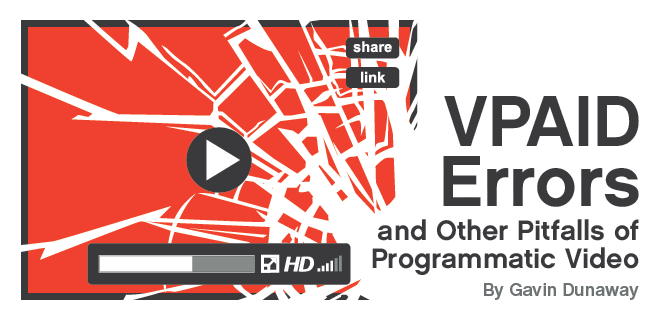
“What’s up with my fill rate? Why are the video ads loading so slow?”
Those are the two questions publishers really don’t want to be asking themselves when it comes to digital video – especially if they’re dabbling in programmatic waters.
High-value video inventory is the moneymaker of the moment for publishers as supply is barely keeping up with advertisers’ feverish demand. In addition to expanded content creation efforts, publishers are exploring video syndication as a path to drive even more revenue out of this channel.
So a low fill rate when demand is so high borders on inconceivable, and latency issues have the potential to drive away both consumers and advertisers.
Programmatic? Programmatic!
But wait, Gavin, the big-time video publishers interject. Why would we bother with programmatic when we regularly and handily sell out our video inventory through direct sales teams?
Well, that sounds lovely for you big-time video publishers, but not all pubs are so blessed. While video ad networks are a way for publishers to offload unsold inventory, programmatic tools like RTB-fueled private exchanges offer them a higher level of control – and potential revenue. (Video ad networks have also jumped into the real-time bidding game.)
And publishers that are selling all their video inventory directly could be leaving revenue on the table. Even though video is more branding-focused and less about direct response, advertisers still want to target their audiences via first- and third-party data. For all the commotion over panel-based audience metrics leading TV buyers to digital video, such metrics are evaluated post impression – real-time targeting has become a force of habit with advertisers.
According to Forrester, real-time digital video auctions will rack up $686 million in advertiser spend in 2013, a 71% jump from 2012 and about a fifth of the 3.6 billion in total video ad spend for 2013. In 2014, the picture gets rosier, with Forrester estimating that real-time auction spend will rise to a $1.1 billion share of the $4.6 billion video market (about 24%). An IHS study has an even more impressive growth arc for programmatic video buying in Europe.
As more money flows through programmatic buying channels, premium publishers are testing the video private exchange waters. First, it’s a matter of meeting advertisers where they want to spend their money, and second, video’s higher level of scarcity (compared to display) supports the notion that advertisers will pay a premium for audience targeting.
Just like display, integrating programmatic video leads to some hiccoughs – namely, trouble with fill rates and latency. But this is where the two channels part ways – on an operational level, they’re very different beasts even before you get to the programmatic trading.
Though understanding the nuances of how programmatic video operates – particularly in regards to the VAST and VPAID standards – and the prevailing pitfalls around fill rates and latency, publishers will have a leg up in implementing this channel as part of a forward-thinking digital video strategy.
 Crash Course on Video Standards
Crash Course on Video Standards
The dark ages of video ad serving were not that long ago. Lack of standardization plagued the ecosystem – as is common in our industry, divergent systems did not know how to talk to each other.
With the addition of a new third party delivering ads, a publisher design team would have to amend the site’s video player (many of these publisher video players were custom built) so it could receive and understand information from this new source. On the opposite side, a third-party ad source would need to customize its platform every time it added a new publisher platform. It was highly inefficient, costly and a giant time-suck.
Then a miraculous light shone down on the industry, and it was called VAST. Standing for Video Ad Serving Template, VAST is a common language between ad servers, publisher video players and third-party providers – at its core, it allows third-party providers to easily serve ads into a publisher video player, provided all three parties are using the same baseline version of VAST (v. 3.0 was released in July 2012).
According to the IAB, an attached VAST (commonly referred to as a “VAST tag,” though this is inaccurate as a VAST is actually a URL) “describes expected video player behavior when executing VAST-formatted ad responses.” As Sarah Kirtcheff said in one of AdMonsters’ most popular pieces, a VAST “simply tells the player the ad is there to display, here is the link to it and this is how long it should play for.”
While the introduction of VAST dramatically increased the scalability of video buying and selling through efficiency, the standard has its limitations, such as supporting a finite number of in-stream units. Hence the development of VPAID (Video Player Ad-Serving Interface Definition), a standard that, when layered upon VAST, enables the ad unit itself to communicate with the video player, which will offer a set of common functionalities that the ad can execute on.
Because VPAID is an interface, it is also an application – consumer-player interactivity is offered through software logic executed as part of the video ad playback. In turn advertisers can collect a richer set of interactivity metrics. VPAID can also be used as a buy-side decisioning engine in programmatic video trading, which is where problems can appear.
 When an Error Ain’t an Error
When an Error Ain’t an Error
A user hits your video page, sending an ad call into the ether of your private video exchange where it is met by several tempted DSP and agency trading desk suitors. The most attractive of these suitors (better known as the winning bidder) is asked to submit an asset – either a creative or a VPAID application.
In the programmatic display world, the winning bidder would return a creative and the transaction would be complete. However, there’s no application like VPAID in the display world – many buyers use VPAID as a decisioning engine when hosting a marketplace on their end. That means when a video SSP picks the winning bidder (be it a DSP, network or trading desk), that buy source may be throwing its own nested auction.
The buy source may load a VPAID into the publisher player only to find it does not have an actual campaign to run. The potential buyers in the nested, buy-side auction may turn down the impression – perhaps a closer inspection of the metadata left their algorithms unpleased. When an empty VPAID is all that remains, this is (rather misleadingly) chalked up as a VPAID error and the SSP’s auction continues.
A better way to describe what happens is a side effect of using VPAID as a decisioning engine on the ad source’s side. The problem can be avoided entirely if the buyer has an integration with the ad server or SSP, commonly referred to as server-side integration or decisioning. This way the video player no longer relies on the VPAID application to load and enable the decisioning on the client side.
To boost efficiency as well as cut down on errors and “false positives,” this appears to be the direction the industry is moving. However, that’s cold comfort for those currently feeling the effects of VPAID errors on fill rates and load speeds.
SSPs and ad servers have a few ways of dealing with VPAID errors. First is a waterfall method – if the top bidder is a bust, the server/SSP will jump to the next highest bidder. The process will be repeated as many times as it takes for a VPAID and/or a creative appear – or until the server/SSP runs out of buy sources. As you can probably guess, this can increase load time (four or five iterations could cost a few very precious seconds).
A method that circumvents latency concerns is parallel calling – essentially the server/SSP is accepting multiple “winning bids,” allowing nested auctions to occur and running the top bidder that actually shows up with a creative. Since all the calls are occurring simultaneously, no extra time is expended during decisioning.
In addition, publishers can dive deep into the reporting and examining bidding results. For sources with high numbers of VPAID errors, conversations should be started with each regarding whether they have a high enough level of demand. Until the amount of impressions delivered jumps back up, these sources could be de-prioritized to open up space for those with higher demand.
 Daisy-Chain Action
Daisy-Chain Action
VPAID errors are not the only standard-based latency concern facing programmatic video sellers. As an application, VPAIDs can summon multiple VASTS – not just the creative unit, but potentially VASTs from vendors associated with the buy source. These VASTs also have the ability to summon more VPAIDs, setting off a daisy-chain effect.
One publisher likened it to a “Trojan Horse” (the stuff of Greek myth, not the computer virus): advertisers are using VPAID to sneak in vendors offering services such as tracking and verification. The more actions occurring simultaneously, the higher potential for latency.
For publishers highly dependent on programmatic video buying, daisy-chaining is bound to cause serious latency in ad pods and could possibly overload a live stream. The above publisher suggested this kind of daisy-chaining is far less common when dealing with direct-sold inventory – programmatic is a bit more wild territory. While negotiation with ad sources could help publishers protection or prevention is not easy.
Daisy-chaining and VPAID errors highlight that programmatic video is a nascent, yet quickly developing space (mobile opens up a whole other realm of challenges). Buyer demand is invigorating the channel, and though available inventory appears to be increasing at a clip, AdExchanger Head of Research Joanna O’Connell reported from a recent TubeMogul event that “there were both implicit and explicit acknowledgements throughout the event that much more great inventory is needed to effectively meet growing brand marketer demand.”
These technical challenges revolving around video standards demonstrate why publishers are hesitant to drop more premium inventory into the programmatic video channel, especially when many can easily sell out via direct sales efforts.
However, buyer demand is growing, and publishers are incentivized to grab that ramping spend especially if they can get a premium over direct-sold efforts. Understanding potential issues with VAST and VPAID offers publishers insight into the intricate mechanics of programmatic video and how glaringly different this space is from display.